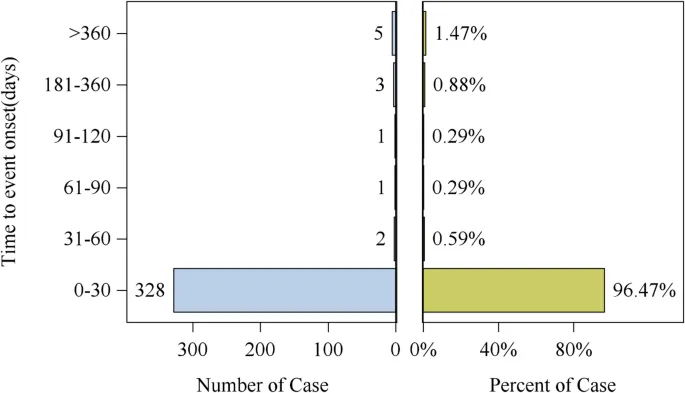
Unveiling the Risks: A Deep Dive into Tirofiban's Safety through Real-World Data
2025-09-01
Author: Emily
The Importance of Antiplatelet Agents in Modern Medicine
Antiplatelet medications like tirofiban are pivotal in the management of life-threatening conditions such as heart attacks and ischemic strokes. These drugs work by blocking platelet aggregation, a key contributor to clot formation in arteries. Tirofiban operates by inhibiting the glycoprotein IIb/IIIa receptors on platelets, effectively preventing them from clumping together and forming dangerous clots.
FDA Approval and Clinical Use of Tirofiban
Originally approved for unstable angina and non-ST elevation myocardial infarction (NSTEMI), tirofiban's significance has evolved as new therapies have emerged. Despite this, it still holds a crucial place in certain cases of percutaneous coronary intervention (PCI), particularly when P2Y12 inhibitors are unavailable. Studies show that a significant number of patients continue to receive GP IIb/IIIa inhibitors during hospital stays, underscoring tirofiban's ongoing relevance in critical care settings.
What the Data Reveals: Insights from the FAERS Database
To better understand the real-world safety profile of tirofiban, researchers turned to the FDA Adverse Event Reporting System (FAERS). This extensive database collects reports from healthcare professionals and consumers about adverse events related to FDA-approved medications. The analysis aims to pinpoint any potential adverse reactions linked to tirofiban, utilizing a method called disproportionality analysis.
The Findings: A Closer Look at Adverse Events Associated with Tirofiban
From the data spanning 2004 to 2024, 2,419 reports involving tirofiban emerged, with a staggering number detailing serious adverse events. The majority of these events occurred within a month of starting the medication, highlighting the urgency medical professionals must consider when using this drug. Notably, hemorrhage was the most frequently reported adverse effect, aligning with the known risks of antiplatelet therapy.
A Concerning Trend: Bleeding and Other Serious Risks
The analysis revealed alarming results regarding bleeding incidents, particularly intracranial bleeding—a significant concern in patients with cerebrovascular conditions. More than 300 cases involved serious bleeding episodes, including gastrointestinal bleeding and hemorrhagic shock. These findings echo the challenges doctors face when balancing the benefits of tirofiban against its risks.
New Adverse Reactions: What’s Not in the Label?
Intriguingly, the study uncovered a range of potential adverse reactions not typically highlighted in tirofiban’s labeling. Reports of acute respiratory failure and other serious conditions raised eyebrows, suggesting that the complexities of this drug's effects warrant further scrutiny. Tirofiban's interactions with other medications, especially anticoagulants, could increase the risk of these complications.
Contextualizing Tirofiban's Risks and Benefits
Despite the risks associated with bleeding, tirofiban remains an essential tool in managing acute coronary syndromes and undergoing PCI. Clinical evidence has consistently backed its effectiveness; however, the risk of adverse events necessitates diligent monitoring and precautionary measures in clinical practice.
Conclusion: A Call for Vigilance and Further Research
This comprehensive analysis of the FAERS database sheds light on the real-world safety profile of tirofiban. While it remains a crucial agent in cardiology and emergency medicine, the indication of serious adverse reactions—especially bleeding—should urge healthcare providers to exercise caution. Continued research and awareness are essential to maximize patient safety and optimize therapeutic outcomes for those at risk.









 Brasil (PT)
Brasil (PT)
 Canada (EN)
Canada (EN)
 Chile (ES)
Chile (ES)
 Česko (CS)
Česko (CS)
 대한민국 (KO)
대한민국 (KO)
 España (ES)
España (ES)
 France (FR)
France (FR)
 Hong Kong (EN)
Hong Kong (EN)
 Italia (IT)
Italia (IT)
 日本 (JA)
日本 (JA)
 Magyarország (HU)
Magyarország (HU)
 Norge (NO)
Norge (NO)
 Polska (PL)
Polska (PL)
 Schweiz (DE)
Schweiz (DE)
 Singapore (EN)
Singapore (EN)
 Sverige (SV)
Sverige (SV)
 Suomi (FI)
Suomi (FI)
 Türkiye (TR)
Türkiye (TR)
 الإمارات العربية المتحدة (AR)
الإمارات العربية المتحدة (AR)